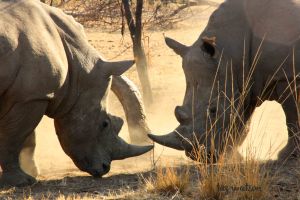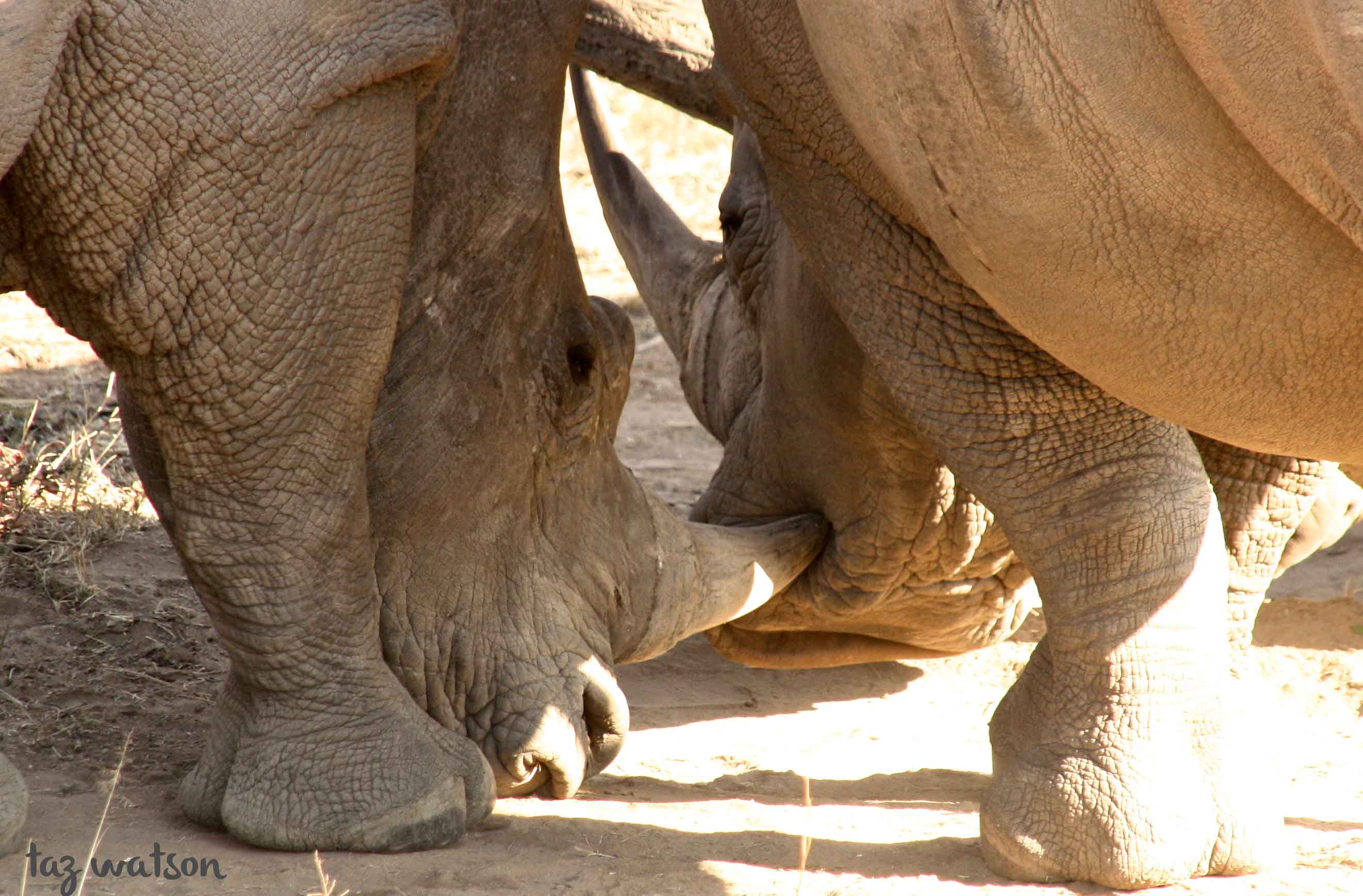Rhino Horns
– Amanda Levine
Rhinos have evolved to have horns for a purpose. They were not created for humans to manipulate, they were intended for a purpose that is necessary to the living standard and survival of the creature. This is an overview of how rhinos use their horns, and the methods that conservationists use to deter poachers from chopping off their horns.
 In my past few weeks in South Africa, I have observed rhinos using their horns in various ways. Rhinos may use their horns for personal sensory or social reasons. On a hot afternoon, we watched a rhino use his horn to dig up the dry cracked dirt to find to cooler dirt to lie in. We also observed many male rhinos rubbing their horns against branches or trees in order to leave their mark. Because of this, it is easier to determine whether or not a rhino is male or female based on the length and shape of their horn. Males tend to have horns that are shorter and thicker than a female rhinos horn.
In my past few weeks in South Africa, I have observed rhinos using their horns in various ways. Rhinos may use their horns for personal sensory or social reasons. On a hot afternoon, we watched a rhino use his horn to dig up the dry cracked dirt to find to cooler dirt to lie in. We also observed many male rhinos rubbing their horns against branches or trees in order to leave their mark. Because of this, it is easier to determine whether or not a rhino is male or female based on the length and shape of their horn. Males tend to have horns that are shorter and thicker than a female rhinos horn.
One necessary way in which rhinos use their horn is for social interactions. The other day we came across two male rhinos, of which one was the dominant bull of the area. A younger male rhino will test his strength as he ages and attempt to battle the dominant bull for territory. When the time comes that the younger male feels strong enough to take over the territory, he will battle the dominant male. Rhino horns are necessary for this type of battle. We have also seen a mother defend her food from another female by fighting with their horns in a sword fight type fashion.
One technique used to deter poachers is to dehorn rhinos. There are many pros and cons to this approach. As one can conclude from the ways rhinos use their horns, dehorning is not a favorable solution. It takes away from what makes rhinos unique, and what tourists from around the world come to Africa to see. The rhino may not amount to all the hype of their “Big 5” status, if they lack a horn. Also, when reserves do dehorn their rhino, they must make sure that they do all of the rhinos within a group that interact with each other. This is because, when some have horns and others don’t, the ones with a horn have an advantage in fighting. When rhinos battle with one another, it can get bad enough that they stab each other with their horns. If one rhino does not have a horn, they have much less of a chance of winning or surviving the battle.
If a reserve does dehorn a group of rhinos together though, there is a fair advantage for each of them, and not much conflict is caused. As with all animals, they learn to live with what they have or don’t have. But despite the resiliency of rhinos to live without their horns, poachers may still come after these dehorned rhinos. In order to not harm the rhino and still dehorn them, the growth plate must be left, or else it would harm the rhino, which is what is trying to be prevented in the first place. It is because of this chunk that is still left inside the rhino’s head that poachers will still attempt to kill and take whatever they can get of the rhinos horn. Also, by dehorning the rhino the liability of the horn is now transferred to the owner of the rhino, which can be dangerous since poachers often attempt to steal horn as well.
Another way conservationists are attempting to protect the rhino and their horn is by injecting a poison and a dye into the horn. Some conservationists believe that this is an unnecessary procedure, while others believe that it is a pertinent practice for the rhinos protection. Rhinos are first sedated and then a red colored dye is injected into the horn. The horn may remain red for around a week and then the color will disappear, but the poison that was injected with the dye will not. This prevents poachers from knowing what rhinos have or have not been through this procedure. At game reserves where this procedure has been done, signs are put up on fences in multiple languages so that poachers know not to poach their rhinos. This procedure has been effective in poisoning some of the clients that purchase the horn. Conservationists hope that not only will this deter poachers, but also become a common occurrence thereby having users of the horn less keen to buy it.
This situation is a very precarious one. It is difficult to know what are the right procedures to take since this is a relatively new dilemma. Thankfully, there are many reserves doing the best they can to protect their rhinos, and only trail and error will allow us to know what is the best solution.

I think that injecting the poison in the animals horn will not only discourage Asian consumers from buying products that contain the horn because they will know that it has been poison but it will discourage poachers from killing the animals for they poisoned horns
. Conservationists are working around the clock from the looks of it to try and find sollutions to the problem and so far this method even though it is expensive and time consuming it seems to be working.